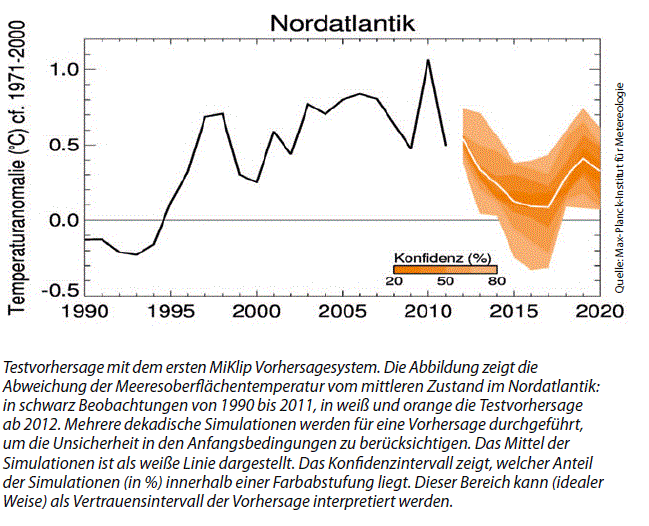So maybe it should not come as surprise that recently the German government quietly put out a bulletin describing a midterm climate forecasting system that is raising some eyebrows.
The first 4 pages of the bulletin discuss and extol the then-upcoming IPCC AR5. Pages 5 - 7 then describe three projects that aim to answer some open climate questions.
Project MiKlip first result shows cooling North Atlantic
The most interesting project among them is the Midterm Climate Prognoses project (MiKlip) described on Page 6 of the Federal Ministry of Education and Research (BMBF) bulletin. Page 6 shows the above chart and poses the question: "How warm is it going to be in 10 years? Business and policy need reliable climate forecasts."
The bulletin adds that "in business and politics there is an increasing need for reliable forecasts for climate developments in the range of years up to a decade."
And to fulfill that midterm need the German government is funding the MiKlip 10-year forecasting system, which comprises 60 individual research projects. Excerpts from page 6:
The above chart on page 6 is a plot of North Atlantic temperature anomaly with respect to the 1971-2000. The chart comes from the Max Planck Institute for Meteorology. The caption reads:It is mainly about computer simulations that use recorded measurement data. ... The MiKlip projects have been taking place since spring 2012. The first tangible results are expected to be available in September 2014. ... Compared to the long-term scenarios, the results should be more exact. ... The model will not deliver a forecast such as the weather at a specific location in a few years. Instead it looks more at the probable mean temperature in Europe in a certain month."
Again we have to stress that this is only a "test forecast" with the first MiKlip system. But even so, the preliminary result is interesting in that it points to a serious drop in North Atlantic sea surface temperatures, which of course would have major global climate repercussions, especially in combination with a negative PDO and low solar activity.Test forecast with the first MiKlip forecast system. The figure shows the anomaly of the sea surface temperature from the mean in the North Atlantic with the observed data shown in black from 1990 to 2011. White and orange show the test forecast beginning in 2012. Multiple decadal simulations are conducted for forecast in order to take the uncertainty of the initial conditions into account. The mean of the simulations is depicted by the white curve. The confidence intervals of the forecast (%) are shown in orange."
So why are we being told that warming is continuing unabated when clearly it is not, and is not expected to for another 10 years at least?
And why is the German government funding the MiKlip models to start with? Is it because the 100-year climate models have been such a huge failure? Obviously they have been. And if the 100-year climate models failed spectacularly for even the first 10 or 20 years, then how can they be regarded as reliable for longer terms?
MiKlip is an important step back towards responsible and serious climate modeling and a sign that governments are finally abandoning the failed long-term models, having recognized that over the mid-term they are grotesquely flawed and have been terribly misleading, e.g. see here.
MiKlip is a nice step away from the dubious 100-year climate fortune-telling (which is naively, simplistically and solely based on the concentration of a single trace gas) and a real step back towards sound science. We are very much looking ahead to the first results.




Reader Comments
to our Newsletter